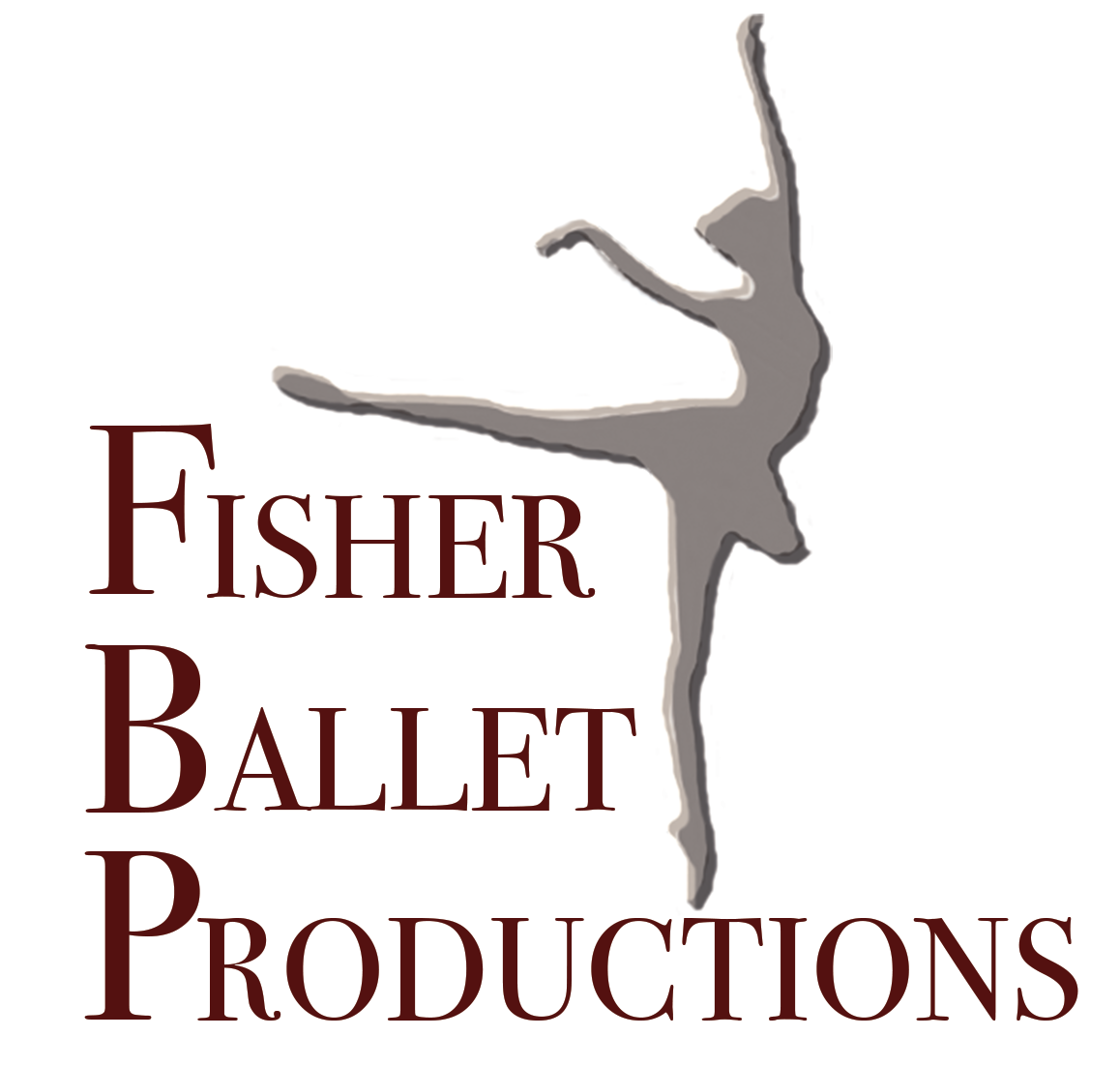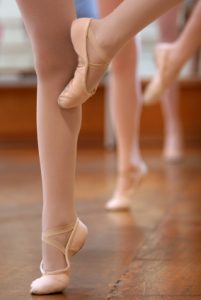
Ballet
The ballet syllabus is a carefully constructed progressive curriculum that builds upon mastery of previous levels. Ballet at the primary level consists of simple stretches and movement coordination as well as imagination and expression. Students learn the basic structure of a ballet class and practice, steps such as skips, marches, and rhythym. They begin to learn a few ballet steps such as plies, rises, and point and closing of the feet. Props such as skarves and sometimes costumes are used. When students begin Ballet I at age 7, they begin the first formal ballet lessons and begin to use the barre. They learn proper placement, turnout, correct alignment, foot articulation and are introduced to the beginnings of formal ballet steps at the barre and in center. Students can expect to be in Ballet I for one to two years before moving up to Level II. Great care is taken to ensure proper placement of children in levels so that they can progress at the right pace for each individual child. Waiting until a child has mastered the technique of one level fully before progressing to the next is crucial for continued improvement without developing bad habits or risking injury. As children progress through the levels, the number of classes per week for their level increases. Children in level III can expect to take three classes per week and will be recommended to begin pointe work on an individual basis at some time during level III. Level IV students take at least 4 classes per week including pointe. Levels V and VI are advanced pre-professional levels and take at least 5-6 classes per week. Pointe, variations and pas de deux are regular components of the advanced levels. Ballet is offered at all levels from Beginner to Advanced, ages 3 through Adult. Recreational Ballet classes are also offered for Children, Teens and Adults who only wish to take one class per week. Special Boys only classes are offered for boys studying ballet.
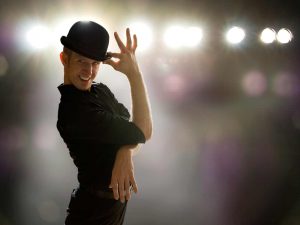
Jazz Musical Theater Dance
Jazz dancing is a common form of dance used in musical theater and commercial and entertainment industries, with its roots in social dance and African-American dance. The performance style of jazz dance was popularized to a large extent by Bob Fosse’s work, which is exemplified by Broadway shows such as Chicago and Cabaret. Modern jazz dance continues to be an important element of musical theatre, and it can often be seen in music videos and competitive dance. To excel in jazz, dancers need a strong foundation in classical ballet.
Tap Dance
Tap dance is a form of dance characterized by using the sound of one’s tap shoes hitting the floor as a percussive instrument. The sound is made by shoes with a metal tap on the heel and toe. Two major variations on tap dance exist: rhythm (Jazz) tap and Broadway tap. Broadway tap focuses more on the dance, and is widely performed as a part of musical theater. Rhythm tap focuses more on musicality, and practitioners consider themselves to be a part of the Jazz tradition.
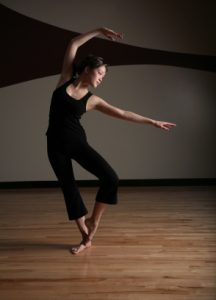
Lyrical Jazz Dance
Lyrical dance style is a subset of Jazz Dance and has its primary basis in ballet, combining the many technical elements of classical ballet with the freedom and airier aspects of jazz, contemporary and modern dance. Lyrical dance is expressive, simultaneously subtle and dynamic, focused on conveying musicality and emotion through movement. It is commonly set to popular music with vocals.
Modern/Contemporary Dance
In the early 1900s European and American dancers started to rebel against the rigid constraints of Classical Ballet. Shedding the authoritarian controls surrounding classical ballet technique, costume, and shoes, these early modern dance pioneers focused on creative self-expression rather than on technical virtuosity. Modern dance is a more relaxed, free style of dance in which choreographers use emotions and moods to design their own steps, in contrast to ballet’s structured code of steps. It has a deliberate use of gravity, whereas ballet is rigid in its technique. Because of the common history, the two forms (classical ballet and modern) share a similar terminology and structure. Ironically, modern dancers usually need to have a high degree of ballet training and nowadays, professional ballet dancers perform a lot of modern dance and it has become an obligatory part of a ballet dancer’s training. College dance programs typically look most heavily at an applicant’s ballet and modern dance training during the audition process.
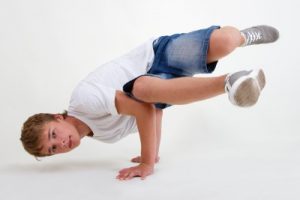
Hip Hop
Hip-hop dance is a broad category that includes a variety of urban dance styles set to hip-hop or rap music. Hip-hop dance (new style) is characterized as hard-hitting involving flexibility and isolations—moving a specific body part independently from others. The feet are grounded, the chest is down, and the body is kept loose so that dancers can easily alternate between hitting the beat or moving through the beat. This is in contrast to ballet and ballroom dancing where the chest is upright and the body is stiff. In addition, new style hip-hop is very rhythmic, and emphasis is placed on musicality—how sensitive your movements are to the music—and being able to freestyle (improvise). As long as dancers keep the foundational movements, they can add their own (free)style and have a performance that is still hip-hop.

Folk Dance
In addition to the above classes, from time to time, various suplemental classes are offered such as the following dance forms:Indian Dance, Chinese Classical Dance, Middle Eastern Dance, Russian Character Dance, African Dance, Irish Dance, Flamenco, Baroque and Renaissance Dance. These dance forms are important elements of a dancer’s training since professional theatrical productions may often include national dances and today’s dancers need to be very versatile in what they are able to perform.
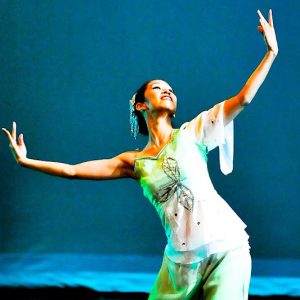
Chinese Dance
What is known today as the traditional Chinese dance emerged over the centuries and is a mix of folk dances from all over China. Nowadays, traditional Chinese dance is becoming more and more popular among the youth. Some popular Chinese dances include: Chinese Ribbon Dance, Chinese Silk Fan Dance, Chinese Round Fan Dance, Chinese Feather Fan Dance, Chinese Classical Dance, Chinese Sword Dance, Chinese Long Sleeve Dance, Chinese Waist Drum Dance, Chinese Lion Dance and Chinese Dragon Dance.
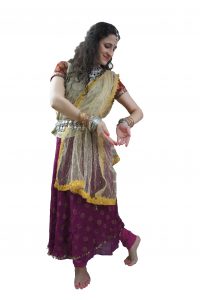
Indian Dance:
Kathak Dance & Bollywood
Kathak Dance comes from Northern India and Pakistan. Its name comes from katha meaning story and it originates from the kathaksor storytellers who used to give religious and moral instruction in narrative form. Music, mime, and dance became important features of their technique and when this mingled with the decorative dance styles introduced by the Moguls (14th-17th centuries) kathak became a complex movement form capable of dealing with the themes of Hindu myth as well as more human stories. Subsequently its narrative content became highly refined (that which remained dealing primarily with the stories of Radha and Krishna) and dancers focused on music and rhythm. Kathak performers are noted for their virtuosic fast turns and stamping footwork, whose rhythms, exaggerated by ankle bells, develop into highly complex metrical sequences. Bollywood Dance is the dance-form used in Indian films. It is a mixture of numerous styles. These styles include belly-dancing, kathak, Indian folk, Western popular dance, modern dance and jazz dance.
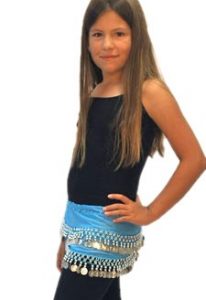
Middle Eastern Dance/ Belly Dance
Most of the movements in belly dancing involve isolating different parts of the body (hips, shoulders, chest, stomach, etc.), which appear similar to the isolations used in jazz ballet, but are often driven differently. Correct posture and muscle control is as important in belly dance as it is in other fields of dance. In most belly dance styles, the focus is on the hip area. Due to the diversity of styles and ‘origins’ of the dance, many of the moves are referred to by a wide variety of different terminologies. However, from an observer’s point of view bellydance includes certain key elements. Important moves are:
- Shiver or Shimmy – a shimmering vibration of the hips. This vibration is usually layered onto other movements to create depth in performance. The shimmy can be performed in different directions – up and down, side-to-side, or in a forward and back swinging motion.
- Hip hits – A staccato movement of the hips out from the body. This can also be performed using other body parts such as the shoulders or chest.
- Undulations – Fluid movements of the hips or of the chest and abdominal muscles in a circular or rotating fashion. There are a wide variety of movements of this kind, of which the most well known is probably the rotating movements of the chest forward, up, back and down to create the impression of riding a camel.
Different styles also incorporate kicks and arm movements as an integral part of the style.

Character Dance
Character Dance is a specific subdivision of classical. It is the stylized representation of a traditional folk or national dance, mostly from European countries, and uses movements and music which have been adapted for the theater. Character dance is integral to much of the classical ballet repertoire. A good example of character dance within ballet is the series of national dances which take place at the beginning of Act III of Swan Lake. The ballets Don Quixote, Paquita, Sleeping Beauty, Coppelia, Raymonda, and Nutcracker also feature many character variations. Popular character dance adaptations for ballet also include the national dances of Hungary, Russia, Poland, Italy and Spain:czardas, mazurka, tarantella, flamenco, etc. One of the best known schools that incorporate character dance to teaching syllabus is the Vaganova Ballet Academy. Outside of Russia and the former republics of the late Soviet Union, there is little training in the art of character dance. However, it is still widely taught in the United Kingdom and Australia and in Central Europe (Czech Republic, Hungary) and it is integral to the training of students at the Royal Ballet School and the Australian Ballet School. It is also taught as a separate skill within the graded examinations syllabus of the Royal Academy of Dance.
